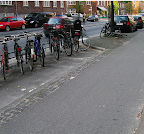This is what the future of media looks like | Hamish McKenzie
-
What if the polarizing mess of social media, clickbait headlines and
addictive algorithms isn't a breakdown of media but a transition to
something better? ...
Click on image to enlarge
Firstly, we can try to increase the amount of people cycling instead of driving. To start with, we could set up a fine network of bike paths, bike lockers, and a woonerf system:
Bike Lanes: Improve safety and linkages
 On the main roads (Wellington & Gold Street & Alexander Parade) we could replace the existing on-road bike lanes with off road paths in the style which are common in Denmark and the Netherlands.
On the main roads (Wellington & Gold Street & Alexander Parade) we could replace the existing on-road bike lanes with off road paths in the style which are common in Denmark and the Netherlands.This would improve safety for cyclists by protecting them from turning or swerving traffic, parking cars and opening car doors, and overtaking motorbikes. It also makes it safer for kids to ride, who are sometimes too unpredictable to ride on the road.
If we want to increase rates of cycling – it’s also important to improve the linkages or connections across the city wide bike network. A bike lane is no good if it doesn't go anywhere, or stops existing for 200m right at a busy intersection. In one sense, this is difficult to address on a local level, on the other hand, if everyone tried to improve their own local bike networks, the larger system would look after itself.
The plan above is the 'ideal' design (as per the approach discussed earlier), when other considerations are included it may not be able to be this extensive.
Before & After Slideshow - showing possible configuration of Wellington Street with bike paths on the same level as pedestrians
 Bike lanes in Copenhagen are commonly configured so that they run alongside the footpath, rather than between parked cars and the traffic. The images in this post are from the great blog Copenhagenize the Planet, which also has this cycle-cam video of a ride through the city: it really shows what a difference it makes to have good consistent, uninterrupted, bike paths to travel on.
Bike lanes in Copenhagen are commonly configured so that they run alongside the footpath, rather than between parked cars and the traffic. The images in this post are from the great blog Copenhagenize the Planet, which also has this cycle-cam video of a ride through the city: it really shows what a difference it makes to have good consistent, uninterrupted, bike paths to travel on.
 Bike lanes in Copenhagen are commonly configured so that they run alongside the footpath, rather than between parked cars and the traffic. The images in this post are from the great blog Copenhagenize the Planet, which also has this cycle-cam video of a ride through the city: it really shows what a difference it makes to have good consistent, uninterrupted, bike paths to travel on.
Bike lanes in Copenhagen are commonly configured so that they run alongside the footpath, rather than between parked cars and the traffic. The images in this post are from the great blog Copenhagenize the Planet, which also has this cycle-cam video of a ride through the city: it really shows what a difference it makes to have good consistent, uninterrupted, bike paths to travel on.Woonerf: Streets are for Playing On
 On the local streets (Charlotte, Hotham and Keele) we could implement a series of Woonerven. The Woonerf is another dutch concept (which translates as something like ‘recreation yard' or maybe 'living street') ; the idea is that you create a zone where pedestrians and cyclists have legal priority over motorists. Vehicles entering the area are restricted to ‘walking pace’ (about 7-10km per hour). Pedestrians, including children, use the entire street and kids are encouraged to play in the street. Yay!
On the local streets (Charlotte, Hotham and Keele) we could implement a series of Woonerven. The Woonerf is another dutch concept (which translates as something like ‘recreation yard' or maybe 'living street') ; the idea is that you create a zone where pedestrians and cyclists have legal priority over motorists. Vehicles entering the area are restricted to ‘walking pace’ (about 7-10km per hour). Pedestrians, including children, use the entire street and kids are encouraged to play in the street. Yay!It has the other advantage of encouraging people to keep off 'local traffic' roads unless they are actually local traffic. The City of Yarra (our local council) are looking at putting in a bunch of speed bumps around our neighbourhood to stop drivers taking short cuts through the back streets at peak hour. A property developer who worked for Central Equity once told me that a speed bump outside your house knocks $20 000 off the value the property because of the annoying 'bump-scrape-bump' noise each time a car goes over the hump - I bet nobody ever lost money on their house because the traffic outside passes slowly enough for the local kids to play a game of hopscotch on the street.
Labels: bikes, sustainable transport, traffic calming, woonerf
0 Comments:
Subscribe to:
Post Comments (Atom)


